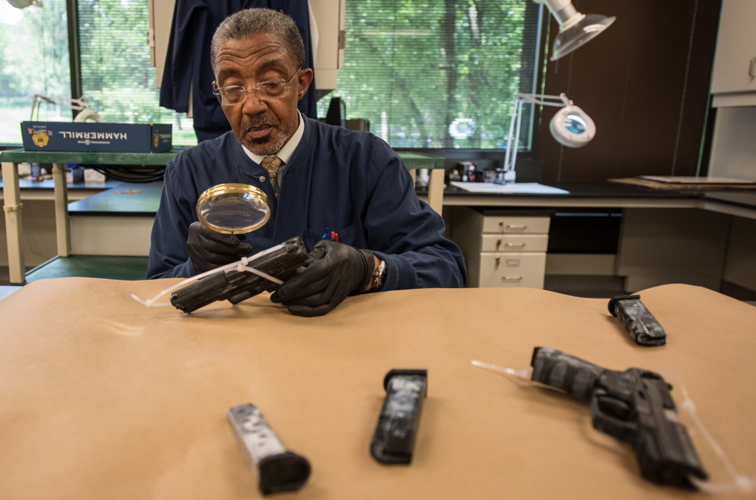Since its creation as the Forensic Document Laboratory in 1978, the ICE Homeland Security Investigations Forensic Laboratory has been the only U.S. crime laboratory specializing in the scientific authentication and research of travel and identity documents and related issues.

Ten years later, in 1988, the laboratory moved to its current location. On July 20, 2016, senior officials from the Department of Homeland Security joined their ICE counterparts for an official, public unveiling that showcased the improvements made over the course of a four-year, multi-phase renovation project that increased the laboratory’s operating space by nearly 10,000 square feet to a total of nearly 40,000 square feet.
Begun in 2012, the recently completed renovation project also reflects the increasing diversity of laboratory services needed to support the mission of ICE Homeland Security Investigations (HSI). Today, the laboratory supports every type of case that ICE and its law enforcement partners investigate – including document fraud, gang-related activity, drug trafficking, bulk cash smuggling, human smuggling, child exploitation, cybercrime, and terrorism. The HSI Polygraph Program, a part of the HSI Forensic Laboratory, conducts polygraph examinations in support of a wide variety of HSI investigations. The renovation also allowed the laboratory to enhance a number of other capabilities, including work with digital media evidence and chemistry as well as research and development efforts.

HSI Forensic Laboratory personnel are often asked to provide essential analysis in ongoing criminal investigations. For example, in 2015, a former Navy Top Gun instructor pilot living in Norfolk, Virginia, was found guilty of producing child pornography and sexually extorting his victims. A forensic scientist from the laboratory was consulted for handwriting analysis and positively identified the suspect as the author of a letter addressed to the Chinese Embassy offering to trade his military information for help in breaking out of jail.
Initially serving to verify the authenticity of travel and identity documents, the ICE HSI Forensic Laboratory now provides advanced forensic, intelligence and investigative training and support to a broad range of federal law enforcement agencies, as well as partner agencies throughout the global law enforcement community. It is worth noting that the laboratory has been accredited since February 17, 2001. The laboratory is currently accredited by the ANSI National Accreditation Board (ANAB) under the International Standard ISO/IEC 17025 General Requirements for the Competence of Testing and Calibration Laboratories in the field of Forensic Testing, specifically in the disciplines of Forensic Document and Friction Ridge Examinations.
The Questioned Document section provides forensic support by examining a full range of documents to determine if they are genuine, counterfeit, or altered.
The forensic document examiners working here specialize in travel and identity document evidence which typically includes passports, visas, driver's licenses, identification cards, and vital records such as birth, death, or marriage certificates. Forensic document examiners also provide expert witness testimony in both administrative and criminal proceedings.

Those who work in the Latent Print section apply scientific expertise and analysis across all investigative program areas, and their services include latent print processing, ink print examinations, comparisons, database searches, expert witness testimony, and field training. In addition to supporting a number of high-profile ongoing investigations, the Latent Print section participates in the HSI Special Agent Cadet Program, and provides ongoing assistance to the agency’s Evidence Recovery Teams.
In 2015, a Hartford, Connecticut, man pleaded guilty to attempting to send to Iran extensive documents and electronic data containing highly sensitive, trade secret and export controlled material relating to U.S. military jet engines, which he had stolen from multiple U.S. defense contractors where he had previously been employed. A fingerprint specialist from the ICE HSI Forensic Laboratory deployed to Los Angeles to support the investigation and was able to retrieve latent fingerprints from various boxes used in shipping the sensitive material, which was a key step in proving that the suspect in the case was the individual who attempted to ship the controlled items.
In terms of volume, the ICE HSI Forensic Laboratory completed more than 1,500 requests for document and fingerprint examination from various agencies in fiscal year 2015. Of these, 1,145 were latent and inked print examinations and 404 were questioned document examinations. The Latent Print section processed more than 22,000 pieces of evidence and the Questioned Document section processed more than 14,000 pieces of evidence.

Another impressive component of the HSI Forensic Laboratory is its reference library, which includes more than 300,000 genuine, counterfeit, and altered travel and identity documents and related reference materials. Like the laboratory itself, the reference library is unique within the federal government and remains the premier resource for the scientific authentication, research, and analysis of travel and identity documents and related issues.
With sample documents provided by more than 200 countries, forensic examiners use the library to authenticate questioned documents and to examine known methods of counterfeiting and alteration. The laboratory’s Operations Section personnel use the library to prepare training materials, produce document intelligence alerts and reference guides, and answer real-time requests from the officers, agents, and investigators in the field. In addition, other agencies, such as Department of State, rely on the library for research and reference.

Serving as both an example of the sort of work being done at the HSI Forensic Laboratory as well as a chilling, daily reminder of the Department of Homeland Security’s overarching mission are copies of several Saudi Arabian passports linked to some of the 9/11 hijackers, including some recovered from the Flight 93 crash site in Shanksville, Pennsylvania. In the days following the terrorist attacks, the FBI submitted these passports that were suspected to be used by the hijackers to the HSI Forensic Laboratory for examination. Forensic examination and analysis determined the passports, as well as the visas they contained, were in fact genuine.















































